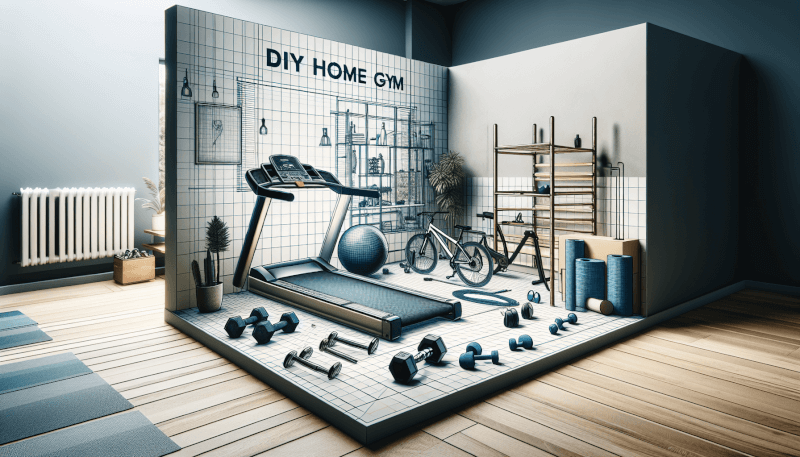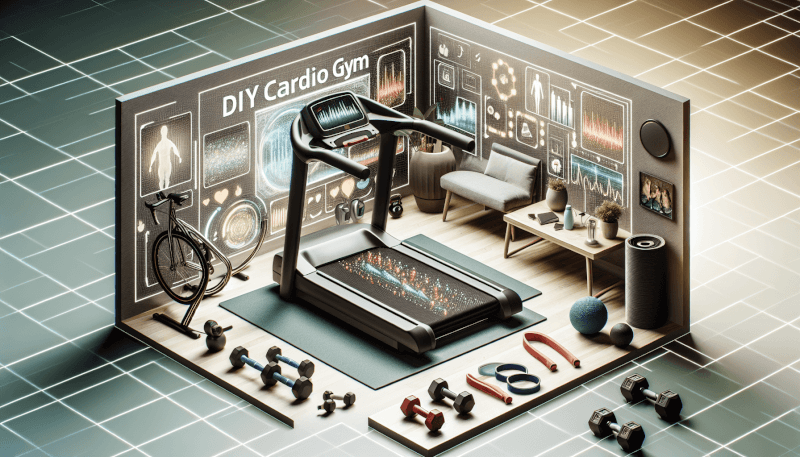Are you tired of paying expensive gym fees and navigating crowded cardio machines? Look no further than creating your own DIY home gym cardio area. With a few simple steps, you can transform a small corner of your home into a convenient and effective space for all your cardiovascular workouts. Say goodbye to long commutes to the gym and hello to the convenience of working out whenever you want. In this article, we will guide you through the process of setting up an effective DIY home gym cardio area that will make you excited to get moving and achieve your fitness goals without ever leaving the comfort of your own home.

Choosing the Right Space
When setting up a cardio area in your home gym, the first step is to carefully consider the available space. Take a look at the different areas in your home and determine which one would be most suitable for your cardio workouts. Ideally, you want a space that is large enough to accommodate the cardio equipment you choose, as well as allow for free movement during your workouts. Consider any existing furniture or fixtures that may need to be moved or removed to make space for your cardio area.
Consider available space in your home
Take into account the dimensions of the room or area you plan to use. A spacious room will allow you to move around comfortably during your workouts, while a smaller space may limit your movements. If you have limited space, consider alternative options such as converting a spare bedroom or utilizing a corner of a larger room.
Assess the flooring
The type of flooring in your chosen space is important. Look for a surface that provides adequate cushioning and support to minimize the impact on your joints during cardio exercises. Hardwood, carpet, or rubberized flooring are good options to consider. Avoid areas with uneven or slippery floors, as these may pose a safety hazard during your workouts.
Evaluate lighting and ventilation
Good lighting and ventilation are essential for creating a pleasant and motivating workout environment. Choose a space with ample natural lighting or invest in artificial lighting that adequately illuminates the area. Additionally, ensure that the room has proper ventilation to keep the air fresh and cool during intense cardio sessions. This will enhance your comfort and help you stay focused on your workouts.
Ensure privacy and minimize distractions
When selecting a space for your cardio area, consider privacy and distractions. Ideally, choose a room or corner of your home that allows you to exercise without interruptions or distractions from other household members. Minimizing distractions will help you stay focused and get the most out of your cardio workouts.
Selecting the Right Equipment
Once you have chosen the perfect space for your home gym cardio area, it’s time to select the right equipment. Choosing the right equipment will depend on your fitness goals, budget, and the available space in your chosen area.
Determine your fitness goals
Before purchasing any cardio equipment, it’s important to determine your fitness goals. Are you looking to improve cardiovascular endurance, burn calories for weight loss, or train for a specific sport? Identifying your goals will guide your equipment choices and help you stay focused during your workouts.
Consider your budget
Setting a budget is crucial when selecting cardio equipment. Determine how much you are willing to invest in your home gym and be realistic about what you can afford. Keep in mind that there are various price points for cardio equipment, so you can find options that fit your budget while still meeting your needs.
Assess the space available
Consider the dimensions and layout of your cardio area when selecting equipment. Measure the available space and take note of any constraints such as low ceilings or narrow doorways that may impact the size or type of equipment you can accommodate. Ensure that the equipment you choose fits comfortably in the space and allows for unrestricted movement during your workouts.
Choose equipment based on your preferences and needs
There are numerous cardio equipment options to choose from, each with its own benefits and features. Popular choices include treadmills, elliptical machines, stationary bikes, rowing machines, stair climbers, and jump ropes. Consider your preferences and needs when making your selection. If you enjoy running or walking, a treadmill may be the best option. If you prefer low-impact workouts, an elliptical machine or stationary bike might be more suitable. Ultimately, choose equipment that you enjoy using and see yourself sticking to in the long run.
Cardio Equipment Options
When it comes to cardio equipment, there are several options to choose from. Each option offers its own unique benefits and features that cater to different fitness levels and preferences. Here are some popular cardio equipment options for your home gym:
Treadmill
A treadmill is a versatile piece of equipment that allows you to walk, jog, or run indoors. It offers a convenient way to get your cardio workout done, regardless of the weather outside. Many treadmills come with various speed and incline settings, allowing you to adjust the intensity of your workouts. Some models even have built-in workout programs or interactive screens that simulate outdoor running routes.
Elliptical machine
An elliptical machine provides a low-impact, full-body workout that targets both the upper and lower body. It mimics the motion of running or walking without the joint impact, making it an excellent option for those with joint issues or injuries. Elliptical machines typically have adjustable resistance levels and some models even offer movable handlebars for an added upper body workout.
Stationary bike
A stationary bike offers a convenient and low-impact method of cardio exercise. It is ideal for individuals of all fitness levels and can be used for both high-intensity intervals and steady-state workouts. Stationary bikes come in various designs, including upright bikes and recumbent bikes, each offering different levels of comfort and support.
Rowing machine
A rowing machine provides a full-body workout that engages multiple muscle groups. It simulates the motion of rowing a boat, offering a low-impact yet challenging cardiovascular exercise. Rowing machines have adjustable resistance settings, allowing you to tailor the intensity of your workout. They are also compact and can be easily folded and stored when not in use.
Stair climber
A stair climber, also known as a step machine or stair stepper, simulates the motion of climbing stairs. It provides an effective cardiovascular workout while also toning and strengthening the lower body muscles. Some stair climbers offer adjustable resistance levels and additional features such as heart rate monitors or built-in workout programs.
Jump rope
Jumping rope offers a simple yet highly effective cardio workout. It is a great option for those with limited space or a tight budget. Jump ropes are portable and can be easily stored when not in use. They provide an intense cardiovascular workout while also improving coordination and agility. Jump ropes are suitable for individuals of all fitness levels and can be used for both high-intensity interval training and steady-state cardio workouts.
These options provide a wide range of choices to suit different preferences, fitness levels, and space constraints. Consider your goals and personal preferences when selecting cardio equipment for your home gym.
Setting Up the Cardio Area
Once you have chosen the right cardio equipment for your home gym, it’s time to set up the cardio area. Proper arrangement and organization of the equipment will ensure a safe and efficient workout environment.
Clear out the designated space
Before arranging the equipment, clear out the designated space to create an open and clutter-free area. Remove any furniture, accessories, or items that may obstruct your movement or pose a safety hazard during your workouts. Clearing the space will provide you with a dedicated area solely for your cardio workouts.
Arrange equipment strategically
Consider the layout of your cardio area and arrange the equipment strategically. Place the larger, bulkier pieces of equipment, such as treadmills or elliptical machines, against the walls to maximize the open space in the center. Smaller equipment, such as stationary bikes or rowing machines, can be positioned in between or alongside the larger equipment. This will ensure that there is enough room to move around and access each piece of equipment easily.
Ensure proper spacing and accessibility
When arranging the equipment, ensure that there is enough space between each piece to allow for comfortable movement and to prevent accidents or injuries. Leave ample space around the equipment for you to step on and off safely. Consider the length of the equipment’s cords or power cables and ensure they are positioned in a way that doesn’t create a tripping hazard.
Consider storage options for accessories
In addition to cardio equipment, you may also have accessories such as weights, resistance bands, or yoga mats. Consider incorporating storage solutions within your cardio area to keep these items organized and easily accessible. Wall-mounted racks, shelving units, or storage bins can help keep your accessories neatly stored and within reach, minimizing clutter in your cardio area.
By setting up your cardio area strategically and efficiently, you will create a space that is easy to navigate, safe to use, and conducive to productive workouts.

Creating a Motivating Environment
A motivating environment is key to staying consistent with your home gym cardio workouts. By adding certain elements to your cardio area, you can create a space that inspires and energizes you.
Install a mirror
Including a large mirror in your cardio area can serve multiple purposes. It not only allows you to check your form and technique during exercises but also creates a sense of spaciousness in the room. Seeing yourself in the mirror can be motivating and help you stay focused on your fitness goals. Additionally, a mirror can reflect natural or artificial light, enhancing the overall brightness of the space.
Bring in some plants
Adding indoor plants to your cardio area can provide a refreshing and calming atmosphere. Plants not only improve air quality but also create a sense of tranquility and natural beauty. Choose plants that thrive in indoor environments with minimal maintenance requirements. Place them strategically around your cardio area to add a touch of greenery and create a peaceful ambiance.
Play energizing music
Music has the power to uplift your mood and motivate you during workouts. Create a playlist of your favorite upbeat songs or choose workout-oriented playlists that match the tempo and intensity of your cardio exercises. Invest in a Bluetooth speaker or utilize a sound system to ensure high-quality sound throughout your cardio area. Playing energizing music will help you stay engaged and enhance your overall workout experience.
Personalize the space with motivational quotes or pictures
Add a personal touch to your cardio area by displaying motivational quotes, pictures, or images that inspire you. Consider creating a vision board with your fitness goals, images of healthy role models, or quotes that resonate with you. Place it somewhere visible within your cardio area, where you can see it during your workouts. These visual cues will serve as constant reminders of why you started your fitness journey and can provide the extra motivation you need to push through challenging workouts.
By incorporating these elements into your cardio area, you will create an inspiring and motivating environment that makes you excited to work out.
Safety Considerations
Safety should always be a top priority when setting up your home gym cardio area. Taking the necessary precautions will help prevent injuries and ensure a safe workout environment.
Perform regular equipment maintenance
Regular maintenance and upkeep of your cardio equipment are crucial for both performance and safety. Follow the manufacturer’s recommendations for maintenance, including lubricating moving parts, checking for loose bolts, and inspecting the overall condition of the equipment. By keeping your equipment in good working order, you minimize the risk of malfunctions or accidents during your workouts.
Keep the area clean and organized
Maintaining a clean and organized cardio area is essential for safety. Regularly clean the equipment and the surrounding area to remove any dust, sweat, or debris. This will prevent slips or falls caused by a slippery surface. Keep cords, cables, and loose accessories secured or properly stored to ensure they don’t become tripping hazards.
Use proper technique and form
Using proper technique and form during your cardio workouts is vital for preventing injuries. Be mindful of your posture and alignment when using the equipment. Adjust the settings, such as seat height or resistance, to match your body mechanics and avoid straining or overexerting yourself. If you are unsure about the correct form, seek guidance from a professional or consider taking online classes that focus on proper technique.
Warm up and cool down before and after workouts
Before starting your cardio workouts, it’s crucial to warm up your muscles and prepare your body for exercise. Incorporate dynamic stretches or light cardio activities to increase blood flow and flexibility. Similarly, after your workout, incorporate a cooldown routine to gradually bring your heart rate down and stretch your muscles. Warming up and cooling down properly reduces the risk of muscle strains or injuries.
Keep emergency contact information accessible
In case of an emergency, it’s important to have emergency contact information readily available. Keep a list of emergency phone numbers nearby, such as those of medical professionals or local emergency services. Additionally, inform a family member or close friend about your workout routine and provide them with your contact information. This will ensure that help can be easily accessed in case of an unforeseen situation.
By following these safety considerations, you can create a secure and injury-free environment for your cardio workouts.

Designing a Workout Routine
To make the most of your home gym cardio area, it’s important to design a workout routine that aligns with your goals and preferences. Here are some tips for creating an effective cardio workout routine:
Set specific goals and target areas
Identify specific goals you want to achieve through your cardio workouts. Whether it’s improving cardiovascular endurance, losing weight, or training for a race, setting clear goals will help you structure your workout routine and track your progress. Additionally, identify specific target areas that you want to focus on, such as lower body strength or overall fitness.
Incorporate a variety of cardio exercises
Varying your cardio exercises will prevent boredom and keep your body challenged. Incorporate a mix of different cardio equipment or activities to work different muscle groups and prevent plateaus. For example, you can alternate between treadmill workouts, elliptical sessions, and outdoor runs to keep your workouts engaging and effective.
Include interval training for maximum efficiency
Interval training involves alternating between periods of high-intensity exercise and active recovery. This type of training is highly effective for improving cardiovascular fitness and burning calories in a shorter amount of time. Incorporate interval training into your cardio routine by including short bursts of intense effort followed by periods of active recovery. This could involve increasing your speed or resistance for a set period, then returning to a moderate pace for recovery.
Allow for rest and recovery days
While cardio exercise is important for maintaining overall fitness, it’s equally important to allow your body time to rest and recover. Incorporate rest days into your workout routine to prevent overtraining and reduce the risk of injury. Use these rest days to engage in light stretching, yoga, or other low-impact activities that promote recovery and relaxation.
Track your progress
Tracking your progress is essential for staying motivated and adjusting your workout routine as needed. Keep a record of your workouts, including the duration, intensity, and any other relevant details. You can use a fitness app, a workout journal, or a simple spreadsheet to track your progress. Regularly review your records to identify patterns or areas for improvement, and celebrate milestones or achievements along the way.
By designing a well-rounded workout routine that combines a variety of exercises and takes your goals into consideration, you can maximize the effectiveness of your cardio workouts.
Creating a Schedule and Sticking to It
Consistency is key when it comes to achieving your fitness goals. Creating a schedule and sticking to it will help you stay committed to your home gym cardio workouts. Here are some tips to help you establish a routine:
Determine the best time of day for your workouts
Identify the time of day when you have the most energy and motivation for your cardio workouts. This could be in the morning before work or in the evening after dinner. Choose a time that works best for your schedule and allows you to prioritize your workouts without feeling rushed or stressed.
Set aside dedicated workout days
Allocate specific days of the week for your cardio workouts and treat them as non-negotiable commitments. Establishing a regular schedule will help you create a habit and ensure that you make time for your workouts. Consider your other obligations and responsibilities when determining the number of days you can dedicate to cardio exercise.
Establish a routine and prioritize workouts
Develop a pre-workout routine that prepares you mentally and physically for your cardio sessions. This could include activities such as stretching, hydrating, or listening to motivational podcasts or music. By establishing a routine, you signal to your mind and body that it’s time for a workout and increase your chances of sticking to your schedule. Prioritize your workouts and treat them as important appointments with yourself.
Hold yourself accountable with a schedule or fitness app
Use a schedule or fitness app to track your workouts and hold yourself accountable. Set reminders or alerts on your phone to ensure that you don’t forget or skip your workouts. There are also various apps available that allow you to schedule your workouts, track your progress, and receive reminders or motivational messages. Utilize these tools to stay on track and maintain consistency.
By creating a schedule that aligns with your lifestyle and priorities, you can establish a routine that supports your cardio workouts and helps you achieve your fitness goals.

Adding Variety to Your Cardio Routine
To keep your cardio workouts exciting and enjoyable, it’s important to add variety to your routine. Here are some ways to mix things up:
Try different cardio equipment
Experiment with different types of cardio equipment to challenge your body in new ways. If you primarily use a treadmill, try incorporating the elliptical machine or stationary bike into your routine. Each equipment offers a unique set of benefits and engages different muscle groups, providing a fresh and stimulating workout experience.
Incorporate outdoor activities and sports
Take advantage of the outdoors by incorporating outdoor activities and sports into your cardio routine. Go for a run or bike ride in your neighborhood, hike on nature trails, or play a sport such as tennis or basketball. Outdoor activities not only provide a change of scenery but also add excitement and variety to your workouts.
Participate in virtual classes or online workouts
Virtual classes and online workout platforms offer a vast array of cardio workouts led by experienced instructors. From dance cardio to kickboxing or high-intensity interval training, you can find classes that suit your preferences and fitness level. Participate in live classes or access pre-recorded workouts to add variety and inspiration to your routine.
Engage in high-intensity interval training (HIIT)
High-intensity interval training (HIIT) involves short bursts of intense exercise followed by brief recovery periods. Incorporating HIIT into your cardio routine can help increase cardiovascular fitness, improve endurance, and burn calories effectively. You can incorporate HIIT by incorporating sprints, burpees, or jumping jacks into your workouts.
Explore dance or martial arts workouts
Dance workouts, such as Zumba or hip-hop cardio, are not only fun but also provide a great cardiovascular workout. Martial arts-based workouts like kickboxing or cardio boxing offer a combination of cardio conditioning and martial arts techniques. These types of workouts can be performed with or without equipment, allowing you to add variety to your routine while improving coordination, agility, and overall fitness.
By regularly introducing variety into your cardio routine, you can keep your workouts interesting, challenge your body in new ways, and prevent boredom or burnout.
Staying Motivated and Consistent
Maintaining motivation and consistency is key to achieving long-term success with your cardio workouts. Here are some strategies to help you stay on track and keep going:
Set realistic and achievable goals
Set goals that are specific, measurable, attainable, relevant, and time-bound (SMART). Avoid setting unrealistic expectations that may be difficult to achieve or maintain. Instead, set smaller milestones that lead to your ultimate fitness goals. Celebrate each milestone reached, no matter how small, to stay motivated and inspired.
Reward yourself for milestones
Rewarding yourself for achieving milestones can create a positive reinforcement loop, making you more likely to stay consistent with your cardio routine. Treat yourself to something you enjoy, whether it’s a relaxing massage, a new workout outfit, or a day off to rest and recharge. The rewards should be meaningful to you and serve as a reminder of your hard work and dedication.
Find an accountability partner or join a fitness community
Having an accountability partner or joining a fitness community can provide the support and motivation needed to stay consistent. Find a workout buddy who shares similar goals and can hold you accountable for your cardio workouts. Alternatively, join online fitness communities or social media groups focused on fitness and wellness. Engage with others, share your progress, and seek inspiration from their journeys.
Track your progress and celebrate achievements
Keep track of your progress to see how far you’ve come on your fitness journey. Use a workout log, a fitness app, or a wearable device to monitor your workouts, duration, and intensity. Celebrate achievements, such as reaching a new distance or setting a personal best, to stay motivated and inspired. Acknowledge and appreciate the progress you’ve made, no matter how small, as it will keep you motivated to continue pushing forward.
By implementing these strategies, you can stay motivated and consistent with your cardio workouts, ultimately leading to better fitness and overall well-being.
In conclusion, creating an effective DIY home gym cardio area involves a thoughtful consideration of available space, selection of the right equipment, strategic arrangement, safety considerations, and a motivating environment. By choosing an appropriate space in your home, assessing your fitness goals and budget, selecting suitable cardio equipment, and setting up the area strategically, you can create a dedicated space for your cardio workouts. Incorporating motivational elements, ensuring safety, and designing a well-rounded workout routine will keep you engaged and motivated. Finally, establishing a schedule, adding variety, and staying consistent with your cardio routine will help you achieve your fitness goals and maintain a healthy lifestyle in the comfort of your own home.



